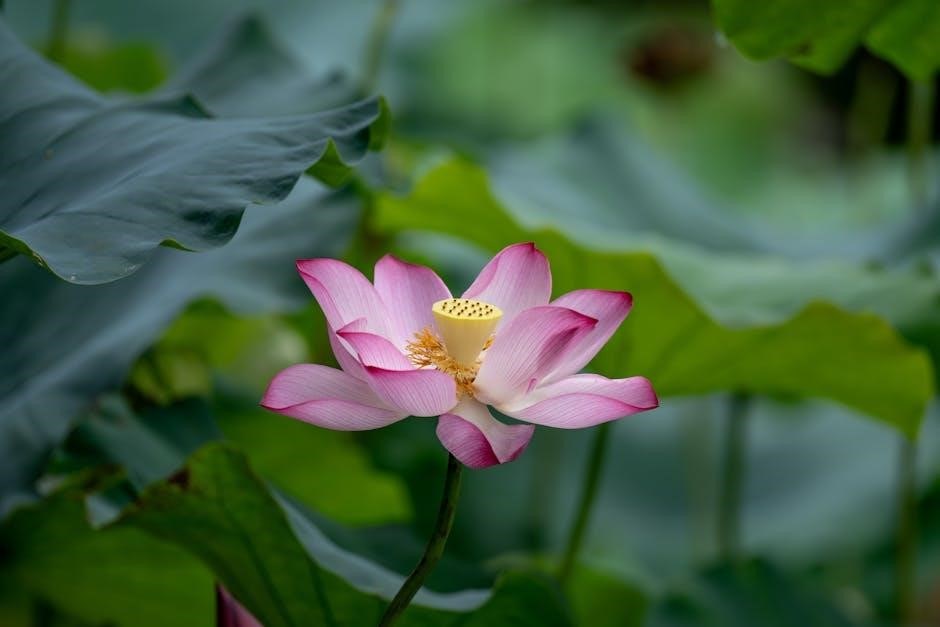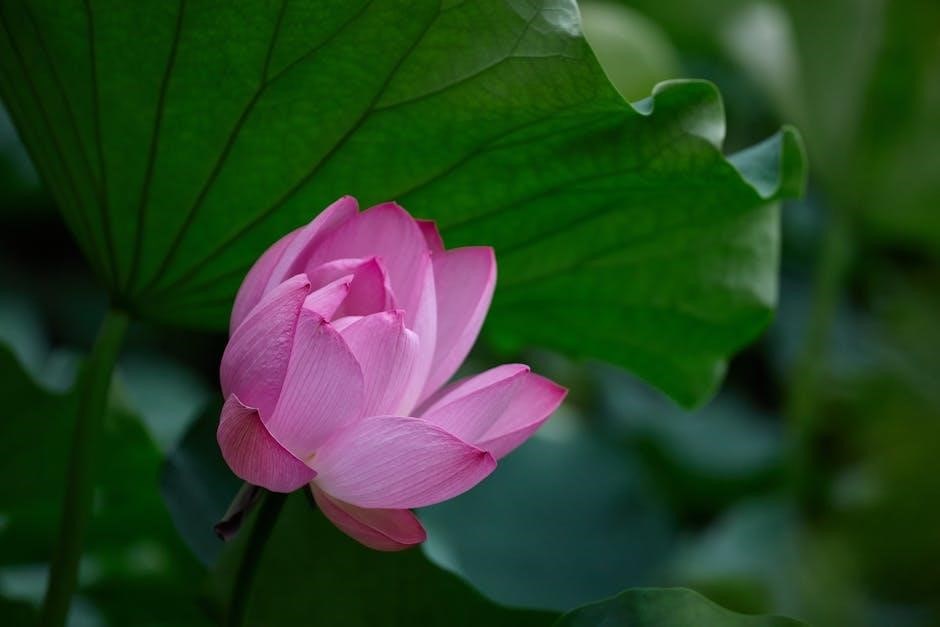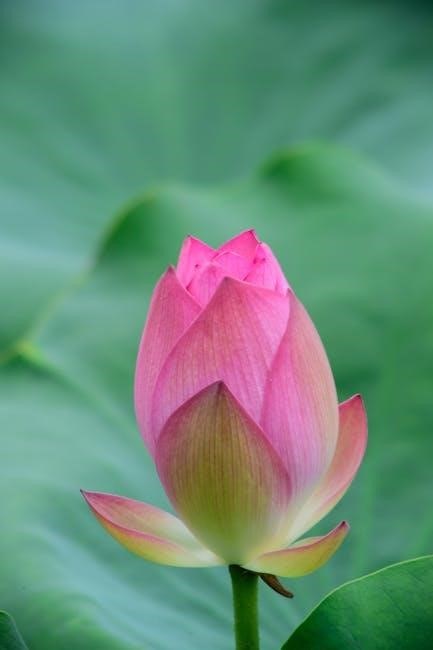The origami lotus flower is a timeless symbol of beauty and simplicity, crafted from a single square paper. Its delicate design and cultural significance make it a popular choice for both beginners and experienced artists. With step-by-step instructions, anyone can create this stunning flower, perfect for gifts or home decor.
Historical and Cultural Significance
The origami lotus flower holds profound cultural and spiritual meaning, rooted in Asian traditions. In Buddhism, the lotus symbolizes enlightenment, purity, and spiritual growth, while in Egyptian culture, it represents rebirth and creation. Origami, an art form with centuries of history, often reflects these symbolic meanings. The lotus, with its intricate folds, is a popular choice for teaching patience and dedication. Historically, origami was used in ceremonies and as a tool for storytelling. Today, the lotus remains a beloved symbol, bridging ancient traditions with modern creativity, making it a timeless and universally appreciated design.

Why Choose the Lotus Flower for Origami
The lotus flower is a quintessential choice for origami due to its symbolic beauty and elegance. Its layered petals create a visually stunning design, making it a rewarding project for both beginners and skilled artists. The lotus is also rich in cultural and spiritual meaning, representing renewal, purity, and enlightenment. Its simplicity in design, combined with its profound significance, makes it a popular and satisfying model to fold. Additionally, the lotus allows for creative customization, such as using textured paper or vibrant colors, ensuring each piece is uniquely personal and aesthetically appealing.

Materials and Tools Needed
A square sheet of origami paper, preferably thin and crisp, is essential. Tools like scissors, a ruler, and a flat surface are also recommended for precision folding.
Best Paper for Origami Lotus Flower
The ideal paper for an origami lotus flower is thin, crisp, and preferably colored on one side. A weight of 125 GSM is recommended for ease of folding. Textured or patterned paper adds visual interest, while solid colors create a sleek look. Avoid thick or bulky papers, as they may tear during intricate folds. Using high-quality origami paper ensures sharp creases and a professional finish. For a vibrant appearance, opt for papers with contrasting colors on each side to highlight the flower’s layers and details.
Additional Tools: Scissors, Rulers, and More

Beyond paper, essential tools for crafting an origami lotus flower include sharp scissors for trimming edges and a ruler for measuring and aligning folds. A bone folder or similar tool can help create crisp creases, while a cutting mat protects your workspace. Optional items like a pencil for marking folds and tweezers for adjusting small details can enhance precision. For added creativity, a spray bottle with water can slightly dampen the paper, making it easier to shape petals. These tools collectively ensure accuracy and ease in folding, helping you achieve a professional finish.

Step-by-Step Folding Instructions
Master the origami lotus by starting with a square paper. Begin with a blintz fold, then create the foundation. Next, fold the petals and assemble the flower, ensuring each step aligns precisely for a stunning result. This methodical approach simplifies the process, making it accessible for both beginners and experienced artists to craft a beautiful origami lotus flower.
Foundation Folds: The Blintz Fold
The blintz fold is the cornerstone of the origami lotus flower, creating a layered base for the petals. Start by folding the square paper in half diagonally and then in half again to form a smaller triangle. Next, fold each corner to the center, ensuring symmetry and precision. This creates a total of eight layers, which will form the foundation for the lotus’s petals. The blintz fold requires patience and accuracy to avoid tears and ensure the paper lies flat. Once completed, this fold sets the stage for crafting the intricate layers of the lotus flower, making it a critical first step.
Creating the Lotus Petals
After the blintz fold, focus on crafting the lotus petals. Fold the top layer of the paper into a small triangle, then gently lift and fold it backward to create the first petal. Repeat this process for each layer, ensuring each petal is evenly spaced and symmetrical. As you progress, the petals will begin to take shape, forming a delicate, layered bloom. Be careful not to tear the paper and maintain precision to achieve a natural, flowing appearance. This step requires patience but is key to bringing the lotus to life with its signature layered beauty.
Assembling the Flower
Once the petals are created, gently bring them together to form the lotus bloom. Secure the base of the petals by tucking the edges under the central fold. Ensure each petal is evenly spaced and aligned for a natural appearance. To enhance stability, you can create a small fold at the base to lock the petals in place. For added realism, a central bud or stamen can be crafted and inserted into the flower’s core. Handle the petals with care to avoid tearing. The assembly step transforms individual folds into a cohesive, stunning lotus flower, ready for display or gifting.

Symbolism and Meaning of the Lotus Flower
The origami lotus symbolizes renewal, enlightenment, and purity. It represents spiritual growth and resilience, making it a meaningful gift or decorative piece.
The Lotus as a Symbol of Renewal and Enlightenment
The origami lotus flower embodies renewal and enlightenment, reflecting its natural counterpart’s journey from darkness to light. Rooted in water yet unsoiled, it symbolizes purity and resilience. Historically, the lotus represents spiritual awakening in many cultures, often associated with Buddhist and Egyptian symbolism. Its unfolding petals mirror personal growth, while its ability to bloom anew each day signifies endless possibilities. Crafting an origami lotus allows creators to connect with these profound meanings, making it a meaningful gift or meditative practice. Its beauty lies not only in its form but also in the deeper truths it carries.
Using the Lotus in Gifts and Decor
The origami lotus flower makes a thoughtful and elegant gift, symbolizing renewal and purity. Its delicate design can be paired with stems and leaves for a stunning bouquet or arrangement. For home decor, display your lotus in a vase or as part of a wall hanging, adding a touch of serenity to any space. Using different colors and patterns allows for personalized gifts or decor that match individual styles. Whether given as a single flower or part of a larger display, the origami lotus brings grace and meaning to any setting.
Variations and Customization

Variations and Customization
Explore creative variations by using different colored and patterned papers. Experiment with unique petal formations and add stems or leaves for a personalized touch.

Using Different Colors and Patterns
Enhance your origami lotus by experimenting with vibrant colors and intricate patterns. Use colored paper to create a gradient effect or layer petals in contrasting hues for depth. Patterned paper, such as floral or geometric designs, adds a unique aesthetic. For seasonal themes, opt for pastel shades in spring or bold tones in autumn. Mixing textures and colors can also elevate the flower’s visual appeal. This customization allows you to tailor the lotus to personal preferences or match specific decor, making each piece truly one-of-a-kind;
Adding Leaves and Stems
Add a finishing touch to your origami lotus with intricately crafted leaves and stems. Use green paper for a natural look, cutting out leaf shapes and attaching them to the base of the flower. Stems can be created by rolling thin strips of paper and securing them beneath the bloom. For added realism, gently curve the leaves and stems to mimic the organic shape of a real lotus. This step enhances the flower’s authenticity and completes its elegant appearance, making it ideal for display or gifting.
Common Mistakes and Troubleshooting
Common mistakes include tearing the paper during folds and misaligning petals. Use crisp paper and fold slowly to avoid tears, ensuring precise creases for accuracy.
Avoiding Tears and Improving Fold Accuracy
To prevent tears, use crisp, thin origami paper and handle it gently. Fold slowly and precisely, especially when inverting folds for petals. Ensure alignment is accurate to avoid misshapen layers. If the paper begins to weaken, pause and allow it to relax before continuing. Using a bone folder can help create sharp creases, reducing the risk of tears. Practice patience, as rushed folds often lead to mistakes. By focusing on deliberate movements and maintaining paper integrity, you can achieve a flawless origami lotus flower with clean, precise folds.
Displaying and Sharing Your Origami Lotus
Create a stunning bouquet or arrangement with your origami lotus flowers for a beautiful display. Share your creations online, inspiring others with your artistic talent and creativity.
Creating a Bouquet or Arrangement
To create a captivating bouquet, gather multiple origami lotus flowers in varying sizes and colors. Arrange them in a vase or container, adding stems and leaves for a natural look. Experiment with layering petals or combining different flower sizes for visual interest. You can also pair the lotus flowers with other origami blooms for a mixed arrangement. For a personalized touch, add decorative elements like ribbons or beads. This display makes a stunning centerpiece or gift, showcasing your artistic skill and creativity. Share your bouquet ideas online to inspire others and celebrate your origami talents.
Sharing Your Work Online
Sharing your origami lotus flower online is a great way to showcase your creativity and connect with fellow enthusiasts. Upload high-quality photos of your finished pieces to platforms like Instagram, Pinterest, or Facebook. Use hashtags like #OrigamiLotus or #PaperCrafts to reach a wider audience. Consider joining origami communities or forums to share your process and learn from others. You can also post step-by-step photos or tutorials to inspire beginners. Encourage feedback and engage with comments to refine your craft. Sharing your work not only celebrates your accomplishment but also helps grow the origami community worldwide.
Crafting an origami lotus flower is a rewarding journey that combines artistry and mindfulness. This traditional design, symbolizing renewal and enlightenment, offers a sense of accomplishment with each fold. Whether gifted, displayed, or shared online, the lotus flower embodies elegance and meaning. The process, while challenging at times, fosters patience and creativity. For beginners and seasoned artists alike, this origami masterpiece serves as a beautiful expression of craftsmanship and cultural appreciation. Embrace the simplicity of paper folding and enjoy the joy it brings to you and others.